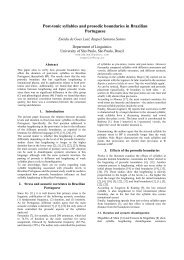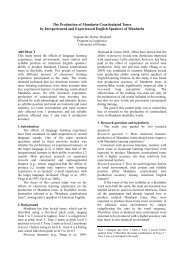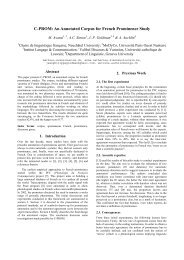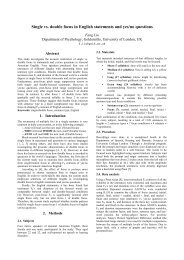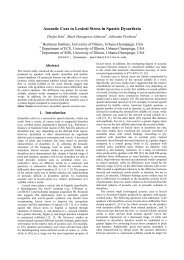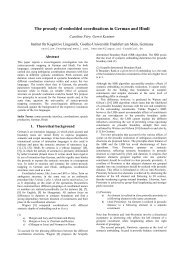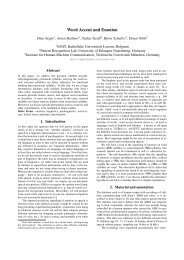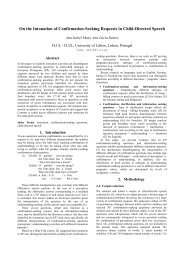Belfast Intonation in L2 speech - Speech Prosody 2010
Belfast Intonation in L2 speech - Speech Prosody 2010
Belfast Intonation in L2 speech - Speech Prosody 2010
You also want an ePaper? Increase the reach of your titles
YUMPU automatically turns print PDFs into web optimized ePapers that Google loves.
Figure 1: FAR scores obta<strong>in</strong>ed <strong>in</strong> the perception test<br />
4. Discussion and Conclusions<br />
Our results suggest that cross-language similarities <strong>in</strong> the<br />
realization of nuclear pitch patterns are (partly) transferred <strong>in</strong>to<br />
<strong>L2</strong>. The realization of more fall<strong>in</strong>g pitch patterns by SG speakers<br />
<strong>in</strong> the English production task accent might po<strong>in</strong>t to an effect of<br />
class room <strong>in</strong>structions. The variety of English taught <strong>in</strong> (Swiss)<br />
German education is based on SBE known to feature fall<strong>in</strong>g<br />
accents <strong>in</strong> nuclear position of declarative utterances. The<br />
comparison of pitch patterns realized by <strong>L2</strong> speakers <strong>in</strong> the<br />
German and English stimuli could be <strong>in</strong>terpreted as transfer from<br />
<strong>L2</strong> to L1. It appears that compared to G speakers <strong>L2</strong> speakers<br />
produced more ris<strong>in</strong>g and ris<strong>in</strong>g-fall<strong>in</strong>g patterns <strong>in</strong> their German<br />
L1, a pitch accent realization seen relatively seldom <strong>in</strong> NSG <strong>in</strong><br />
nuclear position of declaratives.<br />
The results of the perception experiment replicated results<br />
previously found <strong>in</strong> [22]. Additionally, they show that prosodic<br />
similarities between L1 and <strong>L2</strong> facilitate the acquisition of <strong>L2</strong><br />
prosody. In the present case similar realization of ris<strong>in</strong>g and<br />
ris<strong>in</strong>g-fall<strong>in</strong>g pitch patterns <strong>in</strong> SG and BfE suggest that<br />
similarities <strong>in</strong> the target association between L1 and <strong>L2</strong><br />
contribute to a lesser degree of FA. However, a comparison of<br />
scores obta<strong>in</strong>ed for <strong>L2</strong> and SG speakers suggest that there are<br />
more subtle prosodic cues to be acquired then mere target<br />
association and gross pitch movement <strong>in</strong> order to acquire a<br />
native-like <strong>L2</strong> prosody. These prosodic cues might be found<br />
either <strong>in</strong> the alignment of pitch targets to the segmental str<strong>in</strong>g <strong>in</strong><br />
which case FA might rather be seen as a result of erroneous<br />
phonetic implementation. The differences could however also be<br />
caused by prosodic characteristics preced<strong>in</strong>g the actual nuclear<br />
pitch accent, a question that needs to be addressed <strong>in</strong> more<br />
detail. The similar scores for G and SG copy-resynthesized<br />
stimuli suggests that segmental characteristics act as „give-away‟<br />
for FA s<strong>in</strong>ce the extractions of SG prosodic characteristics<br />
yielded a lower FA when transplanted onto G. In summary,<br />
regard<strong>in</strong>g typological similarities [e.g. 15, 13] it seems that<br />
„systemic‟ differences, relat<strong>in</strong>g to differences <strong>in</strong> the <strong>in</strong>ventory of<br />
phonologically dist<strong>in</strong>ct pitch patterns facilitate <strong>L2</strong> acquisition<br />
and thereby result <strong>in</strong> a less „strong‟ FA. However, there are<br />
additional „realizational‟ and „phonotactic‟ differences (details <strong>in</strong><br />
the phonetic realization of what may be phonologically the same<br />
pattern and its permitted structure) that need to be further<br />
<strong>in</strong>vestigated. Therefore, further research needs to address more<br />
global aspects perta<strong>in</strong><strong>in</strong>g to syllables, prosodic words and<br />
<strong>in</strong>tonational phrases and also study potential <strong>in</strong>teraction effects<br />
between prosodic characteristics and the segmental str<strong>in</strong>g by<br />
employ<strong>in</strong>g a larger and more carefully controlled corpus.<br />
5. References<br />
[1] Best, C., “A direct realist view of crosslanguage <strong>speech</strong><br />
perception”, <strong>in</strong> W. Strange [Ed.], <strong>Speech</strong> perception and<br />
l<strong>in</strong>guistic experience: Issues <strong>in</strong> cross-language research,<br />
Timonium, MD: York Press, 171-204, 1995.<br />
[2] Best, C. T., McRoberts, G. W. and Goodell, E., “Discrim<strong>in</strong>ation<br />
of non-native consonant contrasts vary<strong>in</strong>g <strong>in</strong> perceptual<br />
assimilation to the listeners‟ native phonological system”, JASA<br />
109(2): 775-792, 2001.<br />
[3] Boersma, P. and D. Ween<strong>in</strong>k, E., Praat: do<strong>in</strong>g phonetics by<br />
computer (Version 5120). 2005.<br />
[4] Boula De Mareuil, P. and Vieru-Dimulescu, B., “The<br />
contribution of prosody to the perception of foreign accent”,<br />
Phonetica, 63(4): 247-267, 2006.<br />
[5] Brière, E., “An <strong>in</strong>vestigation of phonological <strong>in</strong>terferences”,<br />
Language 42:768-95, 1966.<br />
[6] Fitzpatrick-Cole, J., “The alp<strong>in</strong>e <strong>in</strong>tonation of Bern Swiss<br />
German” ICPHS. 941–944, 1999.<br />
[7] Flege, J. E., Birdsong, D., Bialystok, E., Mack, M., Sung, H. and<br />
Tsukada, K., “Degree of foreign accent <strong>in</strong> English sentences<br />
produced by Korean children and adults”, Journal of Phonetics,<br />
34:153-175, 2006.<br />
[8] Flege, J., “Second language <strong>speech</strong> learn<strong>in</strong>g: Theory, f<strong>in</strong>d<strong>in</strong>gs,<br />
and problems”, <strong>in</strong> W. Strange [Ed.], <strong>Speech</strong> Perception and<br />
L<strong>in</strong>guistic Experience: Issues <strong>in</strong> Crosslanguage Research, 233-<br />
73. Baltimore: York Press. 1995.<br />
[9] Flege, J., “The phonological basis of foreign accent”, TESOL<br />
Quarterly 15: 443-55, 1981.<br />
[10] Gilles, P., „Regionale Prosodie im Deutschen Variabilität <strong>in</strong> der<br />
<strong>Intonation</strong> von Abschluss und Weiterweisung”, L<strong>in</strong>guistik -<br />
Impulse & Tendenzen 6. 2005.<br />
[11] Grabe, E., “<strong>Intonation</strong>al variation <strong>in</strong> urban dialects of English<br />
spoken <strong>in</strong> the British Isles”, <strong>in</strong> P. Gilles and J. Peters [Eds.],<br />
Regional Variation <strong>in</strong> <strong>Intonation</strong>. L<strong>in</strong>guistische Arbeiten,<br />
Tueb<strong>in</strong>gen, Niemeyer, 9-31, 2004.<br />
[12] Grice, M. and Bauman, S., “An Introduction to <strong>Intonation</strong> –<br />
Functions and Models”, <strong>in</strong> J. Trouva<strong>in</strong> and G. Ulrike [Eds],<br />
Non-native <strong>Prosody</strong>: Phonetic Description and Teach<strong>in</strong>g<br />
Practice, 25-52, Mouton de Gruyter, 2007.<br />
[13] Hirst D. and Di Cristo, A., “<strong>Intonation</strong> Systems. A Survey of<br />
Twenty Languages”, Cambridge: Cambridge University Press,<br />
1998<br />
[14] Jilka, M. “The contribution of <strong>in</strong>tonation to the perception of<br />
foreign accent”, PhD thesis, University of Stuttgart. 2000.<br />
[15] Jun , S-A. “Prosodic Typology, The Phonology of <strong>Intonation</strong> and<br />
Phras<strong>in</strong>g”, Oxford, Oxford University Press. 2006.<br />
[16] Magen, H., “The perception of foreign-accented <strong>speech</strong>”,<br />
Journal of Phonetics, 26:381–400, 1998.<br />
[17] Munro, M.J., “Nonsegmental factors <strong>in</strong> foreign accent: Rat<strong>in</strong>gs<br />
of filtered <strong>speech</strong>”, SSLA, 17:17-34, 1995.<br />
[18] Odl<strong>in</strong>, T., Language Transfer: Cross-L<strong>in</strong>guistic Influence <strong>in</strong><br />
Language Learn<strong>in</strong>g. Cambridge University Press, 1989.<br />
[19] Pierrehumbert, J. “The Phonology and Phonetics of English<br />
<strong>Intonation</strong>.” Ph.D. dissertation, MIT. 1980.<br />
[20] Trofimovich, P. and Baker, W., “Learn<strong>in</strong>g second language<br />
suprasegmentals: Effect if <strong>L2</strong> experience on prosody and fluency<br />
characteristics of <strong>L2</strong> <strong>speech</strong>”, Studies <strong>in</strong> Second Language<br />
Acquisition, 28:1-30, 2006.<br />
[21] Ulbrich, C., "Acquisition of regional pitch patterns <strong>in</strong> <strong>L2</strong>", In<br />
<strong>Speech</strong> <strong>Prosody</strong> 2008, 575-578, 2008.<br />
[22] Ulbrich, C. and Mennen, I. (<strong>in</strong> prep.): Dissociation of segments<br />
and <strong>in</strong>tonation <strong>in</strong> <strong>L2</strong>. Bil<strong>in</strong>gualism: Language and Cognition.<br />
Cambridge University Press. Cambridge.<br />
[23] Wode, H., “Categorical perception and segmental cod<strong>in</strong>g <strong>in</strong> the<br />
ontogeny of sound systems: A universal approach” <strong>in</strong> C.<br />
Ferguson, L. Menn and C. Stoel-Gammon [Eds.], Phonological<br />
Development: Models, Research, Implications, 605-31,<br />
Baltimore: York Press, 1992.<br />
[24] Wode, H., “The beg<strong>in</strong>n<strong>in</strong>gs of <strong>L2</strong>-phonological acquisition”,<br />
IRAL 16:109-24, 1978.<br />
.



